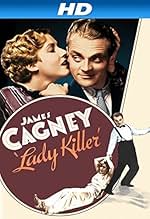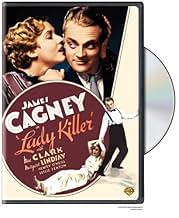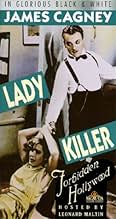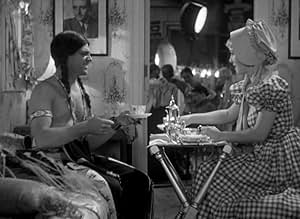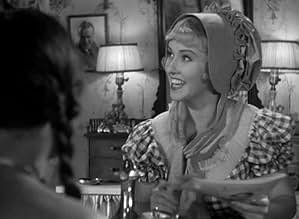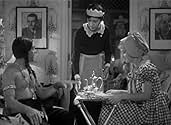VALUTAZIONE IMDb
7,0/10
2057
LA TUA VALUTAZIONE
Aggiungi una trama nella tua linguaA former gangster makes it big in Hollywood, but his old life catches up with him.A former gangster makes it big in Hollywood, but his old life catches up with him.A former gangster makes it big in Hollywood, but his old life catches up with him.
- Regia
- Sceneggiatura
- Star
- Premi
- 1 vittoria in totale
Douglass Dumbrille
- Spade Maddock
- (as Douglas Dumbrille)
William B. Davidson
- Director Williams
- (as William Davidson)
Lowden Adams
- Lois' Butler
- (non citato nei titoli originali)
Luis Alberni
- Director
- (non citato nei titoli originali)
Joseph Belmont
- Monkey Party Guest
- (non citato nei titoli originali)
Brooks Benedict
- Charlie - the Fence
- (non citato nei titoli originali)
Harry Beresford
- Dr. Crane
- (non citato nei titoli originali)
Recensioni in evidenza
"Lady Killer" represents a combination of talents Hollywood will never see again. There is fast talking James Cagney, who starts the movie as a dice playing, gum chewing usher who makes wise guy, but funny, comments to everyone. In Cagney's opening scene, he just makes it to a count out of the 25 ushers, held on the roof of the movie theater they work at. All wear Warner Bros. uniforms, including a cap with the WB logo on it. As Cagney advances in life, he becomes a partner in a gambling operation. One of his confederates slugged too hard a maid and almost kills her during a home robbery, another criminal activity Cagney's gang is involved in. Cagney tells the confederate (played by a snarling Leslie Fenton), what does he think, the police are dumbbells. Dumbbell was a favorite word of screenwriter Ben Markson, who used it to good advantage in another movie he co-wrote, "Gold Diggers of 1933."
Roy Del Ruth does his usual super job, cramming a ton of action into 76 minutes. There is one scene,where the cab of Mae Clarke's character is stopped at one of those old traffic devices, which has two signal vanes, one marked stop, and the other go. The stop signal goes up, another of Cagney's partners,Douglas Dumbrille, happens to be in the adjacent cab, he gets into Clarke's. He tells her "things are plenty hot in New York, I just jumped my bail and beat it out here by plane," to Los Angeles.
Meanwhile, Cagney is being questioned by the LA police, who previously picked him up at the train station on a New York warrant. Cagney tells the police chief, he went West for the climate, on account of his asthma. This scene represents the first mention I know of asthma in a mainstream movie. Later, after Cagney is sprung loose, Brannigan, the cop (played by Robert Elliot, almost typecast to cop roles in the 30s) who first pulled him in at the train station, tells him that if he doesn't find a job, he will be picked up as a "vag" (for vagrant) and get 30 days in jail.
When you look at this scene, notice the outline of the Venetian blinds on the office wall, and the dark shadows falling on the the faces of the Chief, Brannigan and Cagney's character. This scene, and the subsequent scene of Cagney trying to keep a low profile in a pool hall, unshaven and furtive, look as if they were from a film noir movie, only these scenes were made more than 12 years before the film noir cycle started.
The scenes showing Cagney working as a movie extra show how movies were made in the early 1930s, at least according to Roy Del Ruth. There is a scene of Cagney as an Indian chief on an imitation horse riding in front of a back projection screen, the movie director shouting, with a heavy European accent, "Ride, That A Boy!" Later, on a 15 minute lunch break, box lunch in hand, Cagney identifies himself to his future girlfriend, Margaret Lindsay as a Chief with the name, said in Yiddish, Pain In The Ass. I could be off in the translation, but Cagney used a Yiddish phrase.
The movie plot has one unexpected connection to real life. In 1939, there was a New York gangster named Greenbaum, nicknamed "Big Greenie." As I recall, from reading Burton Turkus's book, "Murder, Inc." years ago, Greenbaum fled to the West Coast, where he worked as an extra in movies while avoiding Lepke's killers. Greenbaum knew too much, and Lepke eventually managed to have "Big Greenie" killed.
"Lady Killer" was made in 1933 fast, by great talents. I saw it playing the laserdisc of the movie, part of the double laserdisc of James Cagney movies that Image released in 1992. The second movie on the LD set, "Blonde Crazy," made in 1931, is good also, but the advances made in movie making in two years are really something, comparing the two movies.
There is only one slight flaw in "Lady Killer." In every other pre-Code movie I saw from Warner Bros., when someone reads a telegram, you see the telegram message on screen, the telegram made by the prop department. When the LA police chief shows a telegram to Cagney, explaining the situation, he tells him New York authorities asked him to hold Cagney's character. You never see the actual telegram message, Warners usual practice then, a practice not usually followed by other studios. Maybe Warners' prop department did prepare a fictitious telegram but movie director Roy Del Ruth thought it looked "fakey."
Roy Del Ruth does his usual super job, cramming a ton of action into 76 minutes. There is one scene,where the cab of Mae Clarke's character is stopped at one of those old traffic devices, which has two signal vanes, one marked stop, and the other go. The stop signal goes up, another of Cagney's partners,Douglas Dumbrille, happens to be in the adjacent cab, he gets into Clarke's. He tells her "things are plenty hot in New York, I just jumped my bail and beat it out here by plane," to Los Angeles.
Meanwhile, Cagney is being questioned by the LA police, who previously picked him up at the train station on a New York warrant. Cagney tells the police chief, he went West for the climate, on account of his asthma. This scene represents the first mention I know of asthma in a mainstream movie. Later, after Cagney is sprung loose, Brannigan, the cop (played by Robert Elliot, almost typecast to cop roles in the 30s) who first pulled him in at the train station, tells him that if he doesn't find a job, he will be picked up as a "vag" (for vagrant) and get 30 days in jail.
When you look at this scene, notice the outline of the Venetian blinds on the office wall, and the dark shadows falling on the the faces of the Chief, Brannigan and Cagney's character. This scene, and the subsequent scene of Cagney trying to keep a low profile in a pool hall, unshaven and furtive, look as if they were from a film noir movie, only these scenes were made more than 12 years before the film noir cycle started.
The scenes showing Cagney working as a movie extra show how movies were made in the early 1930s, at least according to Roy Del Ruth. There is a scene of Cagney as an Indian chief on an imitation horse riding in front of a back projection screen, the movie director shouting, with a heavy European accent, "Ride, That A Boy!" Later, on a 15 minute lunch break, box lunch in hand, Cagney identifies himself to his future girlfriend, Margaret Lindsay as a Chief with the name, said in Yiddish, Pain In The Ass. I could be off in the translation, but Cagney used a Yiddish phrase.
The movie plot has one unexpected connection to real life. In 1939, there was a New York gangster named Greenbaum, nicknamed "Big Greenie." As I recall, from reading Burton Turkus's book, "Murder, Inc." years ago, Greenbaum fled to the West Coast, where he worked as an extra in movies while avoiding Lepke's killers. Greenbaum knew too much, and Lepke eventually managed to have "Big Greenie" killed.
"Lady Killer" was made in 1933 fast, by great talents. I saw it playing the laserdisc of the movie, part of the double laserdisc of James Cagney movies that Image released in 1992. The second movie on the LD set, "Blonde Crazy," made in 1931, is good also, but the advances made in movie making in two years are really something, comparing the two movies.
There is only one slight flaw in "Lady Killer." In every other pre-Code movie I saw from Warner Bros., when someone reads a telegram, you see the telegram message on screen, the telegram made by the prop department. When the LA police chief shows a telegram to Cagney, explaining the situation, he tells him New York authorities asked him to hold Cagney's character. You never see the actual telegram message, Warners usual practice then, a practice not usually followed by other studios. Maybe Warners' prop department did prepare a fictitious telegram but movie director Roy Del Ruth thought it looked "fakey."
Jimmy Cagney plays a gangster in this film. However, despite having seen him play such a role in countless other films, this one is unique and well worth seeing because it STILL dares to be different.
Cagney is a wanted man back East, so he gets the idea of going to the West Coast to hang out and wait for things to die down. However, once there he is discovered by Hollywood and stars in gangster films because he is "so natural and believable". Well, despite his very shady past, Cagney tries to go straight and likes the life of a star. However, old associates realize who he is and try to blackmail him.
The film is a light comedy that invigorates the standard gangster genre. For its uniqueness and excellent acting and writing, the film gets an 8.
Cagney is a wanted man back East, so he gets the idea of going to the West Coast to hang out and wait for things to die down. However, once there he is discovered by Hollywood and stars in gangster films because he is "so natural and believable". Well, despite his very shady past, Cagney tries to go straight and likes the life of a star. However, old associates realize who he is and try to blackmail him.
The film is a light comedy that invigorates the standard gangster genre. For its uniqueness and excellent acting and writing, the film gets an 8.
Lady Killer (1933)
*** (out of 4)
James Cagney plays a movie usher who gets fired and then gets mixed up with some gangster being led by Douglas Dumbrille and Margaret Lindsay. Soon a crime goes wrong so Cagney runs off to Hollywood where he starts work as an extra but quickly becomes a movie star. This is an enjoyable little comedy that works pretty well as a spoof of Hollywood and it gives Cagney a chance to make fun of his own image. Cagney is very good in his role, which once again shows him as a cocky, high tempered thug but there's also other moments including Cagney playing an Indian as well as showing off his comic side. Mae Clarke plays Cagney's love interest in Hollywood and the two are very good together with that infamous scene of Cagney dragging her across the floor by her hair. Both Lindsay and Dumbrille add nice support in their roles. One of the film's highlights is when Cagney orders two dozen monkeys to a party where they escape and cause all sorts of trouble. There's also plenty of nice gags aimed at Hollywood and directors. The film starts to run out of steam during the final act but if you're a fan of Cagney or films of this era then this is certainly worth checking out.
*** (out of 4)
James Cagney plays a movie usher who gets fired and then gets mixed up with some gangster being led by Douglas Dumbrille and Margaret Lindsay. Soon a crime goes wrong so Cagney runs off to Hollywood where he starts work as an extra but quickly becomes a movie star. This is an enjoyable little comedy that works pretty well as a spoof of Hollywood and it gives Cagney a chance to make fun of his own image. Cagney is very good in his role, which once again shows him as a cocky, high tempered thug but there's also other moments including Cagney playing an Indian as well as showing off his comic side. Mae Clarke plays Cagney's love interest in Hollywood and the two are very good together with that infamous scene of Cagney dragging her across the floor by her hair. Both Lindsay and Dumbrille add nice support in their roles. One of the film's highlights is when Cagney orders two dozen monkeys to a party where they escape and cause all sorts of trouble. There's also plenty of nice gags aimed at Hollywood and directors. The film starts to run out of steam during the final act but if you're a fan of Cagney or films of this era then this is certainly worth checking out.
When you think of James Cagney, you think of a gangster in films like The Public Enemy, where he smashed that grapefruit into Mae Clarke's face. But Cagney won his Oscar for Yankee Doodle Dandy. He also received nominations for Angels With Dirty Faces and Love Me or Leave Me.
Here he shows just how far his range extends in a romantic comedy which also includes Mae Clarke in a bigger role than you are probably accustomed to seeing her. There is a lot of action in this 76 minute film. Cagney is a theater usher who gets fired and ends up following Mae as she is trolling for suckers to get fleeced by her partners in a card game. He joins the group and they pull bigger more sophisticated cons until a trigger happy gang member kills a servant during a home robbery.
He and Mae head to Los Angeles, and when the LA police hold him for what happened in New York, Myra and one of the gang make off with Cagney's money. The LA police ultimately have to let him go, but penniless he gets increasingly shaggy and ragged looking. This causes him to get picked up for a series of bit parts by a local movie crew exactly because of his scruffy looks. One of the fascinating bits here is seeing how movies were made at the time. He hooks up with star Margaret Lindsay and uses his conning skills to make himself a star. (As an aside, Lindsey made 12 films that year, her second year as an actress.)
Soon, Mae and the gang find him and they want to pick up where they left off, using Cagney to get into posh places that they can rob. He tries to get them out of town, but they see dollars in LA and are going nowhere. How will this all work out? Watch and find out. And like I said, there's a lot of action for 76 minutes and Cagney really shows he can do romance, comedy, and gangster all in one film.
Here he shows just how far his range extends in a romantic comedy which also includes Mae Clarke in a bigger role than you are probably accustomed to seeing her. There is a lot of action in this 76 minute film. Cagney is a theater usher who gets fired and ends up following Mae as she is trolling for suckers to get fleeced by her partners in a card game. He joins the group and they pull bigger more sophisticated cons until a trigger happy gang member kills a servant during a home robbery.
He and Mae head to Los Angeles, and when the LA police hold him for what happened in New York, Myra and one of the gang make off with Cagney's money. The LA police ultimately have to let him go, but penniless he gets increasingly shaggy and ragged looking. This causes him to get picked up for a series of bit parts by a local movie crew exactly because of his scruffy looks. One of the fascinating bits here is seeing how movies were made at the time. He hooks up with star Margaret Lindsay and uses his conning skills to make himself a star. (As an aside, Lindsey made 12 films that year, her second year as an actress.)
Soon, Mae and the gang find him and they want to pick up where they left off, using Cagney to get into posh places that they can rob. He tries to get them out of town, but they see dollars in LA and are going nowhere. How will this all work out? Watch and find out. And like I said, there's a lot of action for 76 minutes and Cagney really shows he can do romance, comedy, and gangster all in one film.
For anyone who enjoys James Cagney, this is a must-see. Yes, it's early in his career, but it's vintage Cagney: cocky, quick-tempered but humorous and likable as always. I am excited to see it finally coming out on DVD in March of 2008.
Instead of being a gangster throughout the story, he starts off that way in New York, runs off to Los Angeles and then goes straight after being hired as a Hollywood extra in a movie. He becomes a star but then his old gang catches up with him and he has to deal with them.
Along the way, three of the supporting actors combine with Cagney to make this a very fast- moving 74-minute film. They are Mae Clark, as the female villain "Myra Gale," Margaret Lindsay at the good woman "Lois Underwood," and Douglass Dumbrille as "Spade," the former leader of the New York gang. All are very convincing in their roles under the able work of director Roy Del Ruth.
You can tell this was a pre-code film just looking at Lindsay's ample cleavage, something that would have been covered up a bit more if the film had been made the following year. Other than that, and a few minor innuendos, the film is pretty clean, morally speaking.
One thing you certainly wouldn't see in today's films was the scene showing Cagney grabbing Clark by the hair and dragging her across the room, then booting her out in the hallway! (This is the same actress who received the famous grapefruit-in-the-face from Cagney in "Public Enemy.")
Anyway, yes the film is dated in much of the dialog and attitudes but it's so entertaining, so much fun to watch that it would still appeal to a good-sized audience today, too.
Instead of being a gangster throughout the story, he starts off that way in New York, runs off to Los Angeles and then goes straight after being hired as a Hollywood extra in a movie. He becomes a star but then his old gang catches up with him and he has to deal with them.
Along the way, three of the supporting actors combine with Cagney to make this a very fast- moving 74-minute film. They are Mae Clark, as the female villain "Myra Gale," Margaret Lindsay at the good woman "Lois Underwood," and Douglass Dumbrille as "Spade," the former leader of the New York gang. All are very convincing in their roles under the able work of director Roy Del Ruth.
You can tell this was a pre-code film just looking at Lindsay's ample cleavage, something that would have been covered up a bit more if the film had been made the following year. Other than that, and a few minor innuendos, the film is pretty clean, morally speaking.
One thing you certainly wouldn't see in today's films was the scene showing Cagney grabbing Clark by the hair and dragging her across the room, then booting her out in the hallway! (This is the same actress who received the famous grapefruit-in-the-face from Cagney in "Public Enemy.")
Anyway, yes the film is dated in much of the dialog and attitudes but it's so entertaining, so much fun to watch that it would still appeal to a good-sized audience today, too.
Lo sapevi?
- QuizFor the scene when Dan Quigley hauls Myra Gale across the apartment floor by her hair and throws her out the door, James Cagney taught his co-star Mae Clarke an old stage trick. When Cagney grabbed hold of Clarke's hair (holding her by the top of her head), Clarke reached up and grabbed Cagney's wrist with both hands. This put her weight on Cagney's wrist, instead of on her hair. Clarke then held on to Cagney's wrist, screaming, as he dragged her across the room.
- BlooperAfter the robbery of the wealthy woman's home, the paper says a maid was struck and seriously injured, and later in Dan Quigley's office, they're still talking about a maid who screams. Later, when the guy who actually hit her comes back scared, he says the butler died.
The owner of the house where Dan was taken after the "car accident" was Mrs. Wilbur Marley. This was the house where the maid was "slugged". The butler who "croaked" was "on the Crosby job".
- Citazioni
Spade Maddock: [discussing diamond-studded Mrs. Marley at the gang's speakeasy] C'mere - take a gander at her.
Dan Quigley: [eyeing her through a peephole] Did you say "gander?" I wonder how she'd go for a goose.
- ConnessioniFeatured in Hollywood: The Great Stars (1963)
- Colonne sonoreIsn't It Heavenly
(1933) (uncredited)
Music by Joseph Meyer
Lyrics by E.Y. Harburg
Played when Myra invites Dan into her apartment.
I più visti
Accedi per valutare e creare un elenco di titoli salvati per ottenere consigli personalizzati
- How long is Lady Killer?Powered by Alexa
Dettagli
- Data di uscita
- Paese di origine
- Lingue
- Celebre anche come
- The Finger Man
- Luoghi delle riprese
- Hinman Hotel, 7th Street and Figueroa Street, Los Angeles, California, Stati Uniti(The opening scene with the theater manager addressing his ushers in military formation is filmed on the rooftop of this hotel building)
- Azienda produttrice
- Vedi altri crediti dell’azienda su IMDbPro
- Tempo di esecuzione1 ora 16 minuti
- Colore
- Mix di suoni
- Proporzioni
- 1.37 : 1
Contribuisci a questa pagina
Suggerisci una modifica o aggiungi i contenuti mancanti



